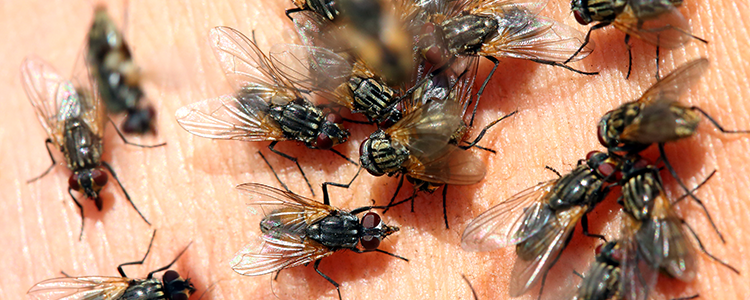The Fascinating Life Cycle of Flies: From Birth to Death
Flies are one of the most common insects found in almost every environment. Their presence is often associated with decay, disease, and discomfort. However, despite their reputation, flies play a crucial role in the ecosystem, helping to break down organic matter and serve as food for other animals. In this article, we will delve into the fascinating life cycle of flies, exploring their development from eggs to adults, their lifespan, and their role in the environment.
The Life Cycle of Flies
The life cycle of flies, also known as the insect life cycle, is a process that involves four stages: egg, larva, pupa, and adult. Each stage has specific characteristics and functions that contribute to the overall development of the fly.
Egg Stage
The egg stage is the first stage in the life cycle of flies. Female flies lay eggs on or near a food source, such as decaying organic matter, manure, or other moist environments. The eggs are typically laid in batches of 100 to 200, and they hatch within 12 to 24 hours. The eggs are small, oval-shaped, and translucent, making them difficult to see without magnification.
Larva Stage
The larva stage is the second stage in the life cycle of flies. The larvae, also known as maggots, are the primary feeding stage of the fly. They feed on decaying organic matter, such as dead animals, plants, or human waste. Maggots are white, legless, and worm-like, with a soft, segmented body. They can grow up to 1 cm in length and are often found in large numbers in areas with abundant food sources.
Pupa Stage
The pupa stage is the third stage in the life cycle of flies. During this stage, the larva transforms into an adult fly. The pupa is a non-feeding stage where the larva undergoes metamorphosis. The pupa is often found in a cocoon or a protective casing, which can be made of silk or other materials. The pupa stage typically lasts for 2 to 14 days, depending on the species and environmental conditions.
Adult Stage
The adult stage is the final stage in the life cycle of flies. Adult flies are the reproductive stage of the fly. They have a lifespan of 2 to 4 weeks, during which they mate and lay eggs. Adult flies have a characteristic body shape with six legs, two wings, and a pair of antennae. They are often attracted to light sources and can be found in large numbers around food sources, garbage, and other decaying organic matter.
How Long Do Flies Live?
The lifespan of flies varies depending on the species, environmental conditions, and availability of food sources. Generally, flies have a short lifespan, ranging from 2 to 4 weeks. However, some species of flies can live up to 6 months or more under optimal conditions. Here are some examples of the lifespan of different fly species:
| Species | Lifespan |
|---|---|
| Housefly | 2-4 weeks |
| Blowfly | 2-6 weeks |
| Fruit Fly | 2-4 weeks |
| Mosquito | 1-2 months |
| Horsefly | 2-6 months |
Factors Affecting Fly Lifespan
Several factors influence the lifespan of flies:
- Food Availability: Flies require a constant supply of food to survive. If food is scarce, their lifespan may be shorter.
- Temperature: Flies thrive in warm temperatures. Cooler temperatures can slow down their development and reduce their lifespan.
- Humidity: High humidity can extend the lifespan of flies, while low humidity can shorten it.
- Predation: Flies are preyed upon by various animals, including birds, spiders, and other insects. This predation can significantly reduce their lifespan.
- Disease: Flies are susceptible to various diseases, which can affect their lifespan.
Role of Flies in the Environment
Despite their reputation, flies play a crucial role in the environment:
- Decomposition: Flies help break down organic matter, such as dead animals and plants, into simpler compounds that can be reused by other organisms.
- Pollination: Some species of flies, like the fruit fly, are important pollinators of plants.
- Food Source: Flies are a food source for many animals, including birds, fish, and other insects.
- Ecological Balance: Flies help maintain ecological balance by controlling populations of other insects and helping to decompose organic matter.
Frequently Asked Questions (FAQ)
- What is the life cycle of flies?
- The life cycle of flies involves four stages: egg, larva, pupa, and adult.
- How long do flies live?
- Flies typically live for 2 to 4 weeks, but some species can live up to 6 months or more under optimal conditions.
- What factors affect the lifespan of flies?
- Food availability, temperature, humidity, predation, and disease all influence the lifespan of flies.
- What is the role of flies in the environment?
- Flies help with decomposition, pollination, serve as a food source for other animals, and maintain ecological balance.
- Can flies live indoors?
- Yes, flies can live indoors, especially in areas with food sources and favorable environmental conditions.
- How do flies reproduce?
- Female flies lay eggs, which hatch into larvae. The larvae grow and transform into pupae, which then develop into adult flies.
- What are the common types of flies?
- Common types of flies include houseflies, blowflies, fruit flies, mosquitoes, and horseflies.
- How do flies help in decomposition?
- Flies help break down organic matter, such as dead animals and plants, into simpler compounds that can be reused by other organisms.
- Are flies harmful?
- While flies can be annoying and carry diseases, they are generally harmless unless they are in large numbers or are vectors for diseases like malaria.
- How can I prevent flies from entering my home?
- Seal any openings around windows and doors, use fly screens, and eliminate food sources and breeding sites.
Comparison of Fly Lifespan with Other Insects
| Species | Lifespan |
|---|---|
| Housefly | 2-4 weeks |
| Honeybee | 6 weeks |
| Ladybug | 1-2 years |
| Ant | 1-2 years |
| Butterfly | 1-2 months |
Source: Wikipedia
Conclusion
Flies are an integral part of the ecosystem, playing crucial roles in decomposition, pollination, and serving as food for other animals. Despite their reputation, flies are fascinating creatures with a complex life cycle that spans from eggs to adults. Understanding their life cycle and role in the environment can help us appreciate the importance of these often-maligned insects.



